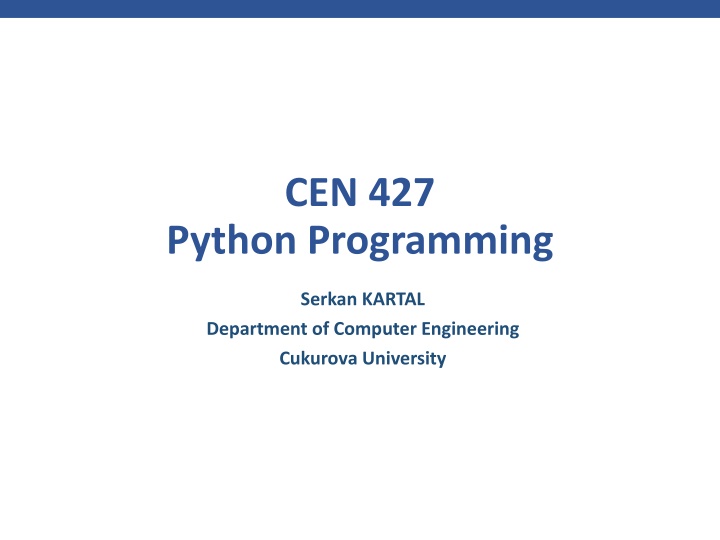
Python Programming Concepts: Lists and Iteration
Explore fundamental Python list operations such as appending, inserting, indexing, removing items, iteration, sorting, and more. Understand the usage of lists in Python with practical examples and tips.
Download Presentation

Please find below an Image/Link to download the presentation.
The content on the website is provided AS IS for your information and personal use only. It may not be sold, licensed, or shared on other websites without obtaining consent from the author. If you encounter any issues during the download, it is possible that the publisher has removed the file from their server.
You are allowed to download the files provided on this website for personal or commercial use, subject to the condition that they are used lawfully. All files are the property of their respective owners.
The content on the website is provided AS IS for your information and personal use only. It may not be sold, licensed, or shared on other websites without obtaining consent from the author.
E N D
Presentation Transcript
CEN 427 Python Programming Serkan KARTAL Department of Computer Engineering Cukurova University
Lists A array of arbitrary values names = [ 'Elwood', 'Jake', 'Curtis' ] nums = [ 39, 38, 42, 65, 111] Adding new items (append, insert) names.append('Murphy ) names.insert(2,'Aretha ) # Adds at end # Inserts in middle Concatenation : s + t s = [1, 2, 3] t = ['a', 'b'] s + t #[1, 2, 3, 'a', 'b']
Lists (cont) Lists are indexed by integers (starting at 0) names = [ 'Elwood', 'Jake', 'Curtis' ] names[0] names[1] names[2] #'Elwood' #'Jake' #'Curtis Changing one of the items names[1] = 'Joliet Jake Length (len) >>> names = ['Elwood','Jake','Curtis'] >>> len(names) 3 Membership test (in, not in) >>> 'Elwood' in names True >>> 'Britney' not in names True Replication (s * n) >>> s = [1, 2, 3] >>> s * 3 [1, 2, 3, 1, 2, 3, 1, 2, 3] >>>
List Searching Finding the first position of an item >>> names = ['Elwood','Jake','Curtis'] >>> names.index('Curtis') 2 >>> names[2] 'Curtis List Removal: Removing an item names.remove('Curtis') Deleting an item by index del names[2] Removing an item does not create a hole. Other items will move down to fill the space vacated. If there are more than one occurrence of the element, remove() will remove only the first occurrence.
List Iteration / List Sorting Iterating over the list contents for name in names: # use name # e.g. print(name) ... Similar to a 'foreach' statement from other programming languages List Sorting s = [10, 1, 7, 3] s.sort() # s = [1, 3, 7, 10] Sorting in reverse order s = [10, 1, 7, 3] s.sort(reverse=True) # s = [10, 7, 3, 1]
Lists and Math Caution : Lists weren't designed for "math" >>> nums = [1, 2, 3, 4, 5] >>> nums * 2 [1, 2, 3, 4, 5, 1, 2, 3, 4, 5] >>> nums + [10, 11, 12, 13, 14] [1, 2, 3, 4, 5, 10, 11, 12, 13, 14] >>> They don't represent vectors/matrices There are some add-ons for this (e.g., numpy)
File Input and Output Opening a file f = open('foo.txt','r') # Open for reading g = open('bar.txt','w') # Open for writing To read data data = f.read([maxbytes]) # Read up to maxbytes bytes To write text to a file g.write('some text ) To close when you're done f.close()
Reading File Data End-of-file indicated by an empty string data = f.read(nbytes) if data == '': # No data read. EOF ... Example: Reading a file in fixed-size chunks f = open(filename,'r') while True: chunk = f.read(chunksize) if chunk == '': break # Process the chunk ... f.close() Writing string data f = open('outfile', 'w') f.write('Hello World\n') ... f.close()
File Management Files should be properly closed when done f = open(filename, 'r') # Use the file f ... f.close() In modern Python (2.6 or newer), use "with" with open(filename, 'r') as f: # Use the file f ... Statements This automatically closes the file when control leaves the indented code block
Reading File Data Read an entire file all at once as a string. with open('foo.txt', 'rt') as file: data = file.read() # `data` is a string with all the text in `foo.txt` Read a file line-by-line by iterating. with open(filename, 'rt') as file: for line in file: # Process the line Write string data. with open('outfile', 'wt') as out: out.write('Hello World\n') ...
Type Conversion In Python, you must be careful about converting data to an appropriate type x = '37' # Strings y = '42' z = x + y # z = '3742' (concatenation) x = 37 y = 42 z = x + y # z = 79 (integer +)
Simple Functions Use functions for code you want to reuse def sumcount(n): '''Returns the sum of the first n integers''' total = 0 while n > 0: total += n n -= 1 return total Calling a function a = sumcount(100) A function is just a series of statements that perform some task and return a result
Library Functions Python comes with a large standard library Library modules accessed using import import math x = math.sqrt(10) import urllib u = urllib.urlopen('http://www.python.org/index.html') data = u.read() Will cover in more detail later
Exception Handling Errors are reported as exceptions An exception causes the program to stop >>> int('N/A') Traceback (most recent call last): File "<stdin>", line 1, in <module> ValueError: invalid literal for int() with base 10: 'N/A' For debugging, message describes what happened, where the error occurred, along with a traceback.
Exceptions Exceptions can be caught and handled To catch, use try-except statement for line in f: fields = line.split() try: shares = int(fields[1]) except ValueError: print ("Couldn't parse", line) ... Name must match the kind of error you're trying to catch >>> int('N/A') Traceback (most recent call last): File "<stdin>", line 1, in <module> ValueError:invalid literal for int() with base 10: 'N/A'
Section 2-Working with Data Overview Most programs work with data In this section, we look at how Python programmers represent and work with data Common programming idioms 16
Primitive Datatypes Python has a few primitive types of data Integers Floating point numbers Strings (text) Obviously, all programs use these None type Nothing, nil, null, nada logfile = None This is often used as a placeholder for optional or missing value if logfile: logfile.write('Some message ) If you don't assign logfile to something, the above code would crash (undefined variable)
Data Structures Real programs have more complex data Example: information about a stock holding: 100 shares of GOOG at $490.10 This is an "object" with three parts Name ("GOOG", a string) Number of shares (100, an integer) Price (490.10, a float)
Tuples A collection of values grouped together Example: s = ('GOOG', 100, 490.1) Sometimes the () are omitted in syntax s = 'GOOG', 100, 490.1 Special cases (0-tuple, 1-tuple) t = () w = ('GOOG ,) # An empty tuple # A 1-item tuple
Tuple Use Tuples are usually used to represent simple records and data structures contact = ('David Beazley', 'dave@dabeaz.com') stock = ('GOOG', 100, 490.1) host = ('www.python.org', 80) Basically, a single "object" of multiple parts. Analogy: A single row in a database table Tuple contents are ordered (like an array). s = ('GOOG', 100, 490.1) name = s[0] # 'GOOG' shares = s[1] # 100 price = s[2] # 490.1 However, the contents can't be modified. >>> s[1] = 75 TypeError: object does not support item assignment You can, however, make a new tuple based on a current tuple. s = (s[0], 75, s[2])
Tuple Packing Tuples are more about packing related items together into a single entity. s = ('GOOG', 100, 490.1) The tuple is then easy to pass around to other parts of a program as a single object. Tuple Unpacking: To use the tuple elsewhere, you can unpack its parts into variables. name, shares, price = s print('Cost', shares * price) The number of variables on the left must match the tuple structure. name, shares = s # ERROR Traceback (most recent call last): ... ValueError: too many values to unpack
Tuples vs. Lists Are tuples just a read-only list? No. Tuples are most often used for a single record consisting of multiple parts record = ('GOOG', 100, 490.1) Lists are usually a collection of distinct items (typically all of the same type) names = ['Elwood', 'Jake', 'Curtis']
Dictionaries A dictionary is mapping of keys to values. A hash table or associative array. The keys serve as indices for accessing values. Example: s = { 'name': 'GOOG', 'shares': 100, 'price': 490.1 }
Dictionaries Getting values: Just use the key names >>> print(s['name'], s['shares']) GOOG 100 >>> s['price'] 490.10 Adding/modifying values : Assign to key names >>> s['shares'] = 75 >>> s['date'] = '6/6/2007' Deleting a value >>> del s['date']
dictionary operations >>> for k in s: print(k, '= , s[k]) name = GOOG shares = 100 price = 490.1 >>> keys = s.keys() >>> keys dict_keys(['name', 'shares', 'price ]) >>>items = s.items() >>>items dict_items([('name', 'GOOG'), ('shares', 100), ('price', 490.1)])
Why dictionaries? Dictionaries are useful when there are many different values those values might be modified or manipulated. Dictionaries make your code more readable. s['price'] # vs s[2]
Containers Programs often have to work with many objects. A portfolio of stocks A table of stock prices There are three main choices to use. Lists (Ordered data.) Dictionaries ( Unordered data) Sets ( Unordered collection of unique items)
Lists as a Container Use a list when the order of the data matters Lists can hold any kind of object Example: A list of tuples portfolio = [ ('GOOG', 100, 490.1), ('IBM', 50, 91.3), ('CAT', 150, 83.44) ] portfolio[0] # ('GOOG', 100, 490.1) portfolio[2] # ('CAT', 150, 83.44)
List construction Example of building a list from scratch records = [] # Initial empty list # Use .append() to add more items records.append(('GOOG', 100, 490.10)) records.append(('IBM', 50, 91.3)) ... Example: Reading records from a file records = [] # Initial empty list with open('Data/portfolio.csv', 'rt') as f: next(f) # Skip header for line in f: row = line.split(',') records.append((row[0], int(row[1]), float(row[2])))
Dicts as a Container Dictionaries are useful if you want fast random lookups (by key name) Example: A dictionary of stock prices prices = { 'GOOG': 513.25, 'CAT': 87.22, 'IBM': 93.37, 'MSFT': 44.12 } >>> prices['IBM'] 93.37 >>> prices['GOOG'] 513.25 >>>
Dict Construction Example of building a dict from scratch. prices = {} # Initial empty dict # Insert new items prices['GOOG'] = 513.25 prices['CAT'] = 87.22 prices['IBM'] = 93.37 Example: Populating from a file prices = {} # Initial empty dict with open('Data/prices.csv', 'rt') as f: for line in f: row = line.split(',') prices[row[0]] = float(row[1])
Dictionary Lookups Test the existence of a key if key in d: # YES else: # NO Looking up a value that might not exist name = d.get(key, default) Example: >>> prices.get('IBM', 0.0) 93.37 >>> prices.get('SCOX', 0.0) 0.0
Sets Sets are collection of unordered unique items. tech_stocks = { 'IBM','AAPL','MSFT' } # Alternative syntax tech_stocks = set(['IBM', 'AAPL', 'MSFT ]) useful for duplicate elimination. names = ['IBM', 'AAPL', 'GOOG', 'IBM', 'GOOG', 'YHOO'] unique = set(names) # unique = set(['IBM', 'AAPL','GOOG','YHOO ]) Additional set operations: unique.add('CAT') # Add an item unique.remove('YHOO') # Remove an item s1 = { 'a', 'b', 'c'} s2 = { 'c', 'd' } s1 | s2 # Set union { 'a', 'b', 'c', 'd' } s1 & s2 # Set intersection { 'c' } s1 - s2 # Set difference { 'a', 'b'
Exercise The file portfolio.csv contains a list of stocks in a portfolio. In Exercise: Read a stock portfolio file into a list of dictionaries with keys name, shares, and price. Read a stock portfolio file into a list of tuples with name, shares, and price.

